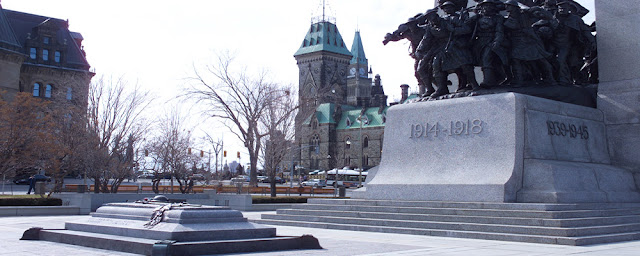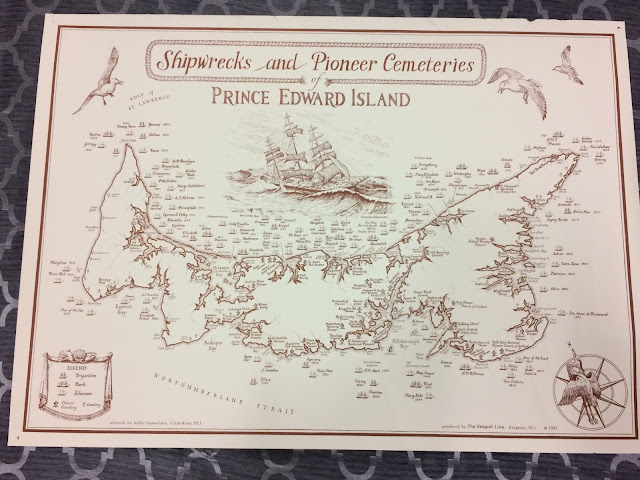Tomb of the Unknown Soldier
The Tomb of the Unknown Soldier has been in the news lately for all the wrong reasons. So today, we are going to look at the creation of the Tomb and why it is important.
 |
| Tomb of the Unknown Soldier and the National War Memorial |
Why An Unknown Soldier
Although soldiers wore identity tags, the destruction of war meant some were missing, destroyed, or unreadable. This was common during the First World War as numerous battles were fought in the same location. While efforts were made to identify remains, sometimes the country the soldier fought for was all that could be identified. After the war, those unknown soldiers identified as Canadians were buried with a gravestone saying "A Canadian Soldier of the Great War - Known Unto God."
Many soldiers' remains were never found. More than 66,000 Canadians died during the First World War. Almost 22,000 have no identifiable grave.
117,000 Canadians have died in all wars since Canada became a country. Of the 117,000, about 28,000 have no known grave.
Creating the Tomb of the Unknown Soldier
The Tomb of the Unknown Soldier was a major undertaking. The Committee responsible for this project included: ANAVETS, NCVA, Veterans Affairs Canada, Department of National Defence, Royal Canadian Mounted Police, Public Works and Government Services Canada, Canadian War Museum, Commonwealth War Graves Commission (Canadian Agency), and National Capital Commission.
This working group, under the chairmanship of retired BGen Duane Daly, the Dominion Secretary of the Legion, met eleven times over the duration of the project.
Initially, the thought was the unknown soldier would be drawn from the casualties of the South African War, the first war Canada was involved in, in the 20th century. A meeting was held with three Veterans organizations, Veterans Affairs Canada, MGen Romeo Dallaire (Canadian Armed Forces), and Harry Needham (Canadian War Museum). The Canadian War Museum was interested in commemorating the 100th anniversary of the beginning of the South African War.
The meeting was held on March 12, 1998. At this meeting, MGen Dallaire argued the soldier should be drawn from Vimy Ridge instead. Dr. Serge Bernier from the Department of Defence pointed out that Newfoundland wasn't part of Canada at the time and therefore there was no possibility the soldier could have been from Newfoundland. However, he did agree that the soldier should be from Vimy Ridge as there was no alternative.
The Battle of Vimy Ridge was the first time Canadian forces fought under Canadian leadership in a major engagement and all four Canadian divisions fought together.
However, as stated earlier, many battles were fought in the exact same area or close by during the First Would War. As a result, all that is known is that this soldier was a Canadian soldier who died during the First World War in that general area. It is unknown if he fought at the Battle of Vimy Ridge.
The Commonwealth War Graves Commission was given the task to select remains from one of the 1,603 unknown Canadians buried near Vimy Ridge. The grave chosen was Grave 7, Row E, Plot 8 of the Cabaret-Rouge British Cemetery in Souchez, France.
 |
| It has become a tradition for Canadians to place poppies on the Tomb of the Unknown Soldier on Remembrance Day. Image from Huffpost (original s from The Canadian Press) |
On May 16, 2000, the soldier's remains were exhumed. On May 25, the Commonwealth War Graves Commission official turned the remains over to Canada. The Canadian Forces took on the responsibility for caring and transporting the unknown soldier to Ottawa.
The unknown soldier was accompanied by a 45-person Guard of Honour, a Chaplain, Royal Canadian Legion veterans, and two representatives of Canadian youth.
Once in Ottawa, the unknown soldier lay in state in the Hall of Honour in Centre Block for three days until the interment ceremony on May 28.
On the morning of May 28, a horse-drawn gun carriage, provided by the RCMP, transported the unknown soldier from Parliament Hill to the National War Memorial. The funeral procession included Queen Elizabeth and Prince Phillip, Governor General Adienne Clarkson, Prime Minister Jean Chretien, Veterans, Canadian Forces Personnel, and RCMP members.
Before the remains were interred, soil from each Canadian province and territory, and France, was placed on the coffin.
The ceremony aired on national television and the unknown soldier was laid to rest in a specially-designed sarcophagus in front of the National War Memorial.
Tomb of the Unknown Soldier Sentry
The Tomb of the Unknown Soldier is one of a few locations with members of the Canadian Armed Forces acting as Sentries during certain seasons.
These sentries "reinforce public awareness that the Tomb is to be treated with dignity, tribute and respect."
Sentries at the Tomb began in July and August 2007. In 2014, the Sentries were expanded to operate between April 9 and November 10 until 2020. The date of April 9th was specifically chosen because it marks the date the Battle of Vimy Ridge began.
The Sentries rotate from the Royal Canadian Navy, Canadian Army, Royal Canadian Air Force, and Canadian Special Operations Command.
Murder at the Tomb of the Unknown Soldier
On October 22, 2014, Cpl. Nathan Cirillo and Branden Stevenson were the Sentries at the Tomb of the Unknown Soldier. Cpl Cirillo was a 24 year old Reservist from Hamilton.
 |
| Brandon Stevenson and Nathan Cirillo (CBC News) |
According to RCMP reports, the shooter, who will not be named, arrived behind the monument on Wellington Street at 9:47 AM. He took out a rifle and shot Cpl. Cirillo three times. Cpl. Cirillo later died in the hospital.
The Tomb of the Unknown Soldier is a stark reminder that in war, not all soldiers come home. Some are lost and will never be found or identified.
I have had the opportunity to visit this site. For those who are lucky enough to have a chance to visit the Tomb of the Unknown Soldier, please remember this is a grave site that represents and honours fallen Canadian soldiers. It should be treated it with the honour and respect it deserves.
"Archived - The Ceremonial Guard - Backgrounder." Government of Canada. 2021/08/24 http://www.army-armee.forces.gc.ca/en/news-publications/national-news-details-no-menu.page?doc=the-ceremonial-guard-backgrounder%2Fjwmfywcz
Baron, Rosemary. "Ottawa Shooting report says Cpl. Nathan Cirillo tried to take cover during attack." CBC News. 2015/05/09. https://www.cbc.ca/news/politics/ottawa-shooting-report-says-cpl-nathan-cirillo-tried-to-take-cover-during-attack-1.3098809
"Bringing the Unknown Soldier Home." Royal Canadian Legion.
https://www.legion.ca/remembrance/promoting-remembrance/memorials-and-cenotaphs/bringing-the-unknown-soldier-home
Cobb, Chris. "War Memorial guard program is designed for dignity." Ottawa Citizen. 2014/10/22. https://ottawacitizen.com/news/local-news/war-memorial-guard-program-is-designed-for-dignity
"Questions and Answers - Tomb of the Unknown Soldier." Veterans Affairs Canada. https://www.veterans.gc.ca/eng/remembrance/memorials/canada/tomb-unknown-soldier/thetomb/tombqanda
"Tomb of the Unknown Soldier." Government of Canada. 2017/10/02.
https://www.canada.ca/en/canadian-heritage/services/art-monuments/monuments/tomb-unknown-soldier.html
"Tomb of the Unknown Soldier. Veterans Affairs Canada. 2021/12/10. https://www.veterans.gc.ca/eng/remembrance/memorials/national-inventory-canadian-memorials/details/9367


Comments
Post a Comment